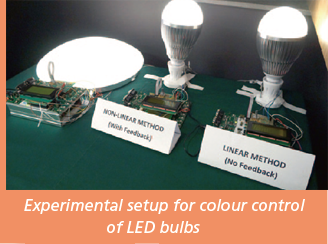Lighting systems consume about 18% of electricity globally. This project focuses on "sustainable lighting technology". It clarifies the
important concept that "energy saving is not necessarily environmentally friendly", unless the technology has long lifetime and a large
portion of the product materials is recyclable. The research team is therefore promoting a new "Sustainability" concept involving three
criteria, namely (1) energy saving, (2) long product lifetime and (3) recyclability. The recent advancement in Light-Emitting Diode (LED)
technology provides a platform for fulfilling these three sustainability criteria for lighting applications.

LED devices are known for their high luminous efficiency and
long lifetime (typically 6 to 8 years). However, the bottleneck of
traditional electronic drivers for LED systems is their relatively
short lifetime of typically 3 years – limited by the lifetime of a
component called electrolytic capacitor. For outdoor applications,
extreme weather conditions such as wide temperature changes
and lightning are also major factors restricting the lifetime of
LED products.
This Theme-based Research Project is jointly carried out by the
HKU team (led by Prof Ron HUI) and PolyU team (led by Prof
Michael TSE). After intensive research for the first two years of
the project period, we have achieved the following:
- The development of a new LED device structure with
low thermal resistance
Heat and light are enemies to each other in LED technology.
In order to maximize the light output, it is necessary to design
an LED device structure that has low junction temperature. In
other words, a good LED device structure should be one that
allows heat to flow out of the device easily. We have
developed a new LED device structure with good thermal
performance. Consequently, high light output from LED
devices becomes feasible.
|
|
- The development of patent-pending "passive" LED drivers
that can fulfil the three sustainability criteria
This technology has been adopted by a Hong-Kong-based
company in the production of passive LED street lamps. These
lamps have a high energy efficiency exceeding 92%, a
designed lifetime exceeding 10 years and 80% of the product
materials being recyclable. It is envisaged to be the world’s
first LED street lamp product of which the LED driver’s lifetime
exceeds that of the LED device. Therefore, this technology is
ideal for outdoor applications.
- The development of "active" LED drivers that are free of
electrolytic capacitors
Without any electrolytic capacitors, the bottleneck in the
lifetime restriction of LED drivers can be removed. New
compact LED products with high efficiency and long lifetime
for indoor applications become possible.
- New colour and dimming control
Colour and dimming control are important functions of LED
systems. In the past, dimming control of LED systems inevitably
affects the colour temperature. We have now developed new
techniques that can separate colour and dimming control so
that colour temperature control can be achieved at a constant
light intensity; and light intensity can be controlled at a
constant colour temperature.
- Extended LED system theory
On the theoretical aspects of the project, we have successfully
developed a Unified Theory linking the interactions of (i) Heat,
(ii) Light, (iii) Electric Power and (iv) Colour in LED systems.
This theory has become a design tool for optimizing LED
systems for a wide range of products. One can now predict
the light intensity and colour variations of an LED system
before building the product.
Prof Ron Shu Yuen HUI
Department of Electrical and
Electronic Engineering
The University of Hong Kong
ronhui@eee.hku.hk
|
